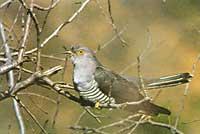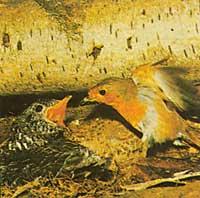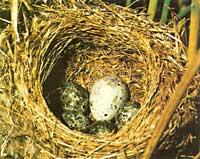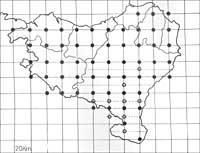Cuckoo, more than one song

In spring, when you have gone to the mountain you will surely have heard the song of the cuckoo. Although his song is well known (for being so alive, strong and clean), many people cannot say that he has seen the cuckoo. The chanting of the cuckoo, like that of other birds, makes the female exercise the function of reclaiming her territory and, at the same time, defending the territory of the males. The female has relationships with some males, so it is polyandric.
You can live in wooded and shrubby areas, specifically in paramos, marshes, farmland, fields and forests.
The size of Kukua ( Cuculus canorus) is 28-33 cm. Keep in mind that it has a long tail, a gray feather above and white below with gray ribbons; in flight it can be mixed with gavilans. Male and female are the same, except for one exception, among females there is a superior reddish liver variety.

The kukuliforme order in Europe, composed exclusively of the common cuckoo and the wet cuckoo ( Clamator glandarius), common throughout the Basque Country, but the second, that is, the wet cuckoo, can only be seen in South Navarre.
In general, after spending the winter in southern Africa, he arrives in Euskal Herria in the last days of March or in April. The trip is 9000 kilometers and is usually night and alone. In early July the adult returns south in search of heat. However, young people attend the last days of September.
Its most important characteristic is its reproduction, that is, it does not nest: it lays its eggs in the nest of other birds. The species most affected by this parasitism are txantxangorri, txepetxa, txinbo, buztangorri, txio and pottery, among others. The wet cuckoo, meanwhile, lays its eggs in the nests of the mica and herbs.

You can also lay twelve eggs in the nests of others. In the nests of the other birds puts an egg with a beak or directly with a roast, which seems to even regularly remove one of them. Some females can add up to twenty eggs. It usually looks for a nest of birds of the same type, of the species they feed. The eggs of the quota and the species mentioned are similar, both in color and in shape. Apparently, the color of the eggs is inherited from the release of his father and mother.
Therefore, it has been considered that natural selection has been very important in the evolution of the quota. The chickens of the cucos, everything around them, the eggs and chickens of the hoteliers, expels them from the nest, pushing them with the back and wings. After four days the instinct of expulsion of the nesting animals disappears, which normally only remains in the nest.
Alone, not to order food from his stepmother. Small birds feed on the young cuckoo, as they do not reach their peak, so they have to pose on their head or fly in front of him. After three weeks it has a lot of weight, so it will leave the nest in others nearby. Three weeks later, he knows how to fly and will be able to feed himself.
Despite its cruel bird appearance, it plays an important role in our forests. Especially in pine forests, it feeds mainly on pine honey. It also eats lipids, worms and insects.
That is why we have to defend the cuckoo, which is one of the few known defenses to combat the pine plague of our forests.
Bibliography
- ALDAZ and EMAZABEL, J. 1918. Catalogue of birds observed in Guipúzcoa and Vizcaya. MEM.R.SOC.ESP.HIST.NAT 10:459-508 BERNIS, F. 1954. Prontuario de la Avifauna española. ARBEOLA:1, 3-85. ELOSEGUI ALDASORO, I. 1985. 11.- Navarre. Ed. Savings Bank of Navarra. GALARZA IBARRONDO, A. and Fernandez Gil, A. 1980. Our birds. Our birds. Petronor. Pp. 131; ITZIAR TA AGUIRRE, M. 1966. Our birds. Lot Kuliska; 62, Itxaropena, Zarautz. pp. 203. PETERSON, R; MOUNFORT, G and HOLLOM, P. AD. 1967. Bird guide from Spain and other European countries. Ed. Omega. pp. 416 FAUS, J.M. 1986 Vertebrates of Álava, Bizkaia and Gipuzkoa. Administration of the Autonomous Community of Euskadi. Related information 1984. Biology/1. Names of plants and animals, nomenclator. Related information Donostia. 533 pp.
Buletina
Bidali zure helbide elektronikoa eta jaso asteroko buletina zure sarrera-ontzian












